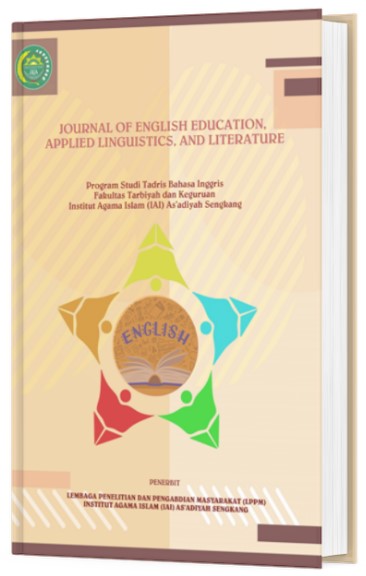STRENGTHENING ENGLISH CURRICULUM IN HIGHER EDUCATION
PENGUATAN KURIKULUM BAHASA INGGRIS ING PENDIDIKAN TINGGI
Keywords:
curriculum development, English language teaching, higher education, communicative competence, professional skills developmentAbstract
This conceptual paper examines the critical need for strengthening English language curricula in higher education institutions to meet evolving global communication demands. Despite English's established position as an international language of academia and commerce, many university pro-grams struggle to develop graduates with adequate English proficiency. Through analysis of current curricular approaches and emerging pedagog-ical frameworks, this article proposes a comprehensive model for curricu-lum enhancement that emphasizes authentic communication, digital litera-cy integration, student-centered methodologies, and continuous assess-ment. The findings highlight that effective English curriculum reinforcement requires systematic alignment between institutional goals, instructor devel-opment, technological resources, and workplace requirements. This con-ceptual framework offers practical guidance for higher education institu-tions seeking to reform their English language programs while acknowl-edging contextual limitations and implementation challenges. The article concludes by emphasizing the transformative potential of strengthened English curricula in preparing graduates for international academic and professional opportunities.
Downloads
References
Blackwood, P., & Thompson, L. (2021). Faculty development for cur-riculum reform: Building implementation capacity in higher ed-ucation language programs. International Journal of Educa-tional Development, 82, 102329. https://doi.org/10.1016/j.ijedudev.2021.102329
Canagarajah, S. (2021). Rethinking English language teaching in global contexts: The plurilithic turn and its implications for cur-riculum design. TESOL Quarterly, 55(1), 36-59. https://doi.org/10.1002/tesq.583
Chapelle, C. A., & Sauro, S. (2023). Digital technologies in language education: Research-based approaches for curriculum integra-tion. Computer Assisted Language Learning, 36(4), 418-442. https://doi.org/10.1080/09588221.2022.2087610
Crystal, D. (2022). English as a global language: Current patterns and future trajectories. World Englishes, 41(1), 1-17. https://doi.org/10.1111/weng.12574
Dimova, S., & Kling, J. (2021). Assessing English-mediated instruc-tion in higher education: Developing frameworks for discipli-nary communication. Language Testing, 38(3), 338-361. https://doi.org/10.1177/0265532221992264
Dockrell, J., & Chen, H. (2023). Professional English communication needs in digital workplaces: Implications for higher education curricula. Journal of English for Academic Purposes, 62, 101148. https://doi.org/10.1016/j.jeap.2022.101148
Ferreira, M., & Nguyen, T. P. (2024). Strategic alignment in language program development: A systems approach to curriculum en-hancement. Higher Education Research & Development, 43(1), 125-143.
Hockly, N., & Dudeney, G. (2021). Digital literacies in language edu-cation: Research, practice and critical perspectives. Language Teaching, 54(1), 57-72. https://doi.org/10.1017/S0261444820000439
Inbar-Lourie, O., & Donitsa-Schmidt, S. (2020). Assessment literacy as praxis: Mediating professional development in language ed-ucation. Language Teaching Research, 24(3), 312-332.
Kawamura, K., & Ishikawa, T. (2020). English language needs in the Japanese workplace: An analysis of industry-specific require-ments. English for Specific Purposes, 59, 191-209. https://doi.org/10.1016/j.esp.2020.06.003
Marlina, R., & Xu, Z. (2020). Integrating global Englishes into the language curriculum: A case study of policy implementation in China and Indonesia. Asian Englishes, 22(1), 68-84.
Martinez-Camacho, M., & Wong, L. (2020). Content and language integrated learning in higher education: A longitudinal study of implementation effects. International Journal of Bilingual Edu-cation and Bilingualism, 23(7), 883-896. https://doi.org/10.1080/13670050.2020.1737075
Martinez-Lopez, N., Fernandez-Santiago, R., & Gonzalez-Perez, L. (2021). Digital communication competencies in graduate em-ployment: A multimodal needs analysis across five industry sectors. Journal of English for Specific Purposes at Tertiary Level, 9(2), 68-97. https://doi.org/10.18485/esptoday.2021.9.2.4
O'Dowd, R., & Dooly, M. (2022). Virtual exchange in higher educa-tion: From telecollaboration to digitally enhanced mobility. Re-CALL, 34(2), 168-188.
Purpura, J. E., & Banerjee, J. (2023). Language assessment literacy for communicative curricula: Developing assessment frame-works for the global age. Language Testing, 40(1), 105-129. https://doi.org/10.1177/02655322221107438
Rahman, M. S., & Singh, M. K. M. (2021). English language skills and employment readiness: Employer perspectives from Southeast Asian contexts. RELC Journal, 52(1), 70-85. https://doi.org/10.1177/0033688220924927
Santos, V. D., & Ramirez, A. C. (2022). Developing workplace com-munication skills through simulation-based curriculum: A quasi-experimental study in engineering education. ESP Today, 10(1), 90-116. https://doi.org/10.18485/esptoday.2022.10.1.5
Shamim, F., & Kuchah, K. (2023). Contextually appropriate method-ology in language education: Navigating global standards and local realities. ELT Journal, 77(1), 83-95. https://doi.org/10.1093/elt/ccac046
Stockwell, G. (2020). Technology-enhanced teaching in higher edu-cation language programs: Learning from research and prac-tice. Language Learning & Technology, 24(3), 1-14.
Tardy, C. M., Sommer-Farias, B., & Gevers, J. (2023). Genre peda-gogy and linguistic diversity: Teaching disciplinary writing in multilingual higher education contexts. Journal of Second Lan-guage Writing, 59, 100921.
Tsagari, D., & Banerjee, J. (2022). Assessment in EMI contexts: Aligning language evaluation with disciplinary learning objec-tives. Studies in Educational Evaluation, 73, 101133. https://doi.org/10.1016/j.stueduc.2022.101133
Washington, K., & Madrigal, D. (2020). Employer expectations for English proficiency: A multi-sector analysis of graduate hiring criteria. Journal of English for Academic and Specific Purpos-es, 45(2), 156-179. https://doi.org/10.1016/j.jeap.2020.03.004
Yilmaz, F., & Schmidt, T. (2021). Assessment practices in higher education English programs: Evaluating impact on teaching and learning outcomes. Language Assessment Quarterly, 18(1), 72-97. https://doi.org/10.1080/15434303.2020.1869225
Zhang, H., Kim, Y., & Andersson, B. (2022). Content and language integration in higher education: A systematic review of class-room practices and learning outcomes. AILA Review, 35(1), 263-289. https://doi.org/10.1075/aila.21010.zha
Downloads
Published
How to Cite
Issue
Section
License
Copyright (c) 2025 Maria Agustina Ledo

This work is licensed under a Creative Commons Attribution-ShareAlike 4.0 International License.







